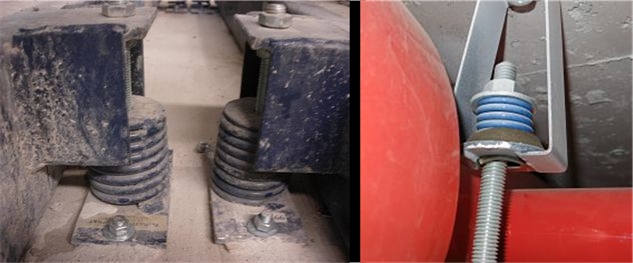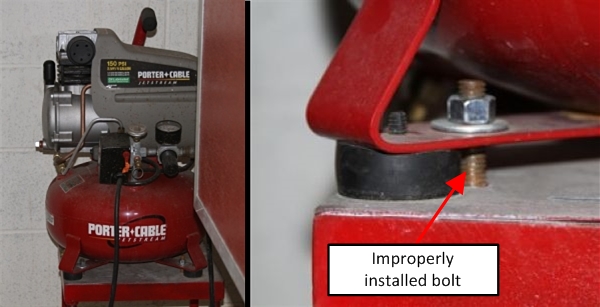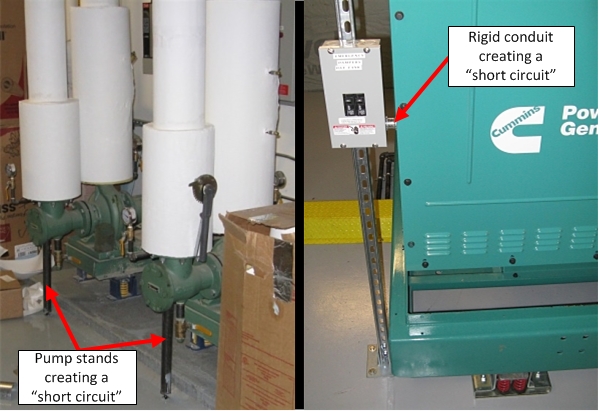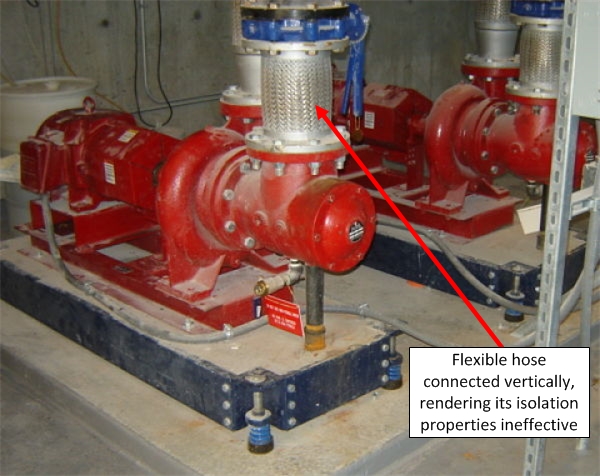In most commercial and industrial buildings, you will find some type of vibration isolation on the mechanical equipment. If the products have been specified and installed correctly, they should be providing a significant reduction in the force transmitted to the structure, relative to the force that would be transmitted if the equipment was “bolted down.” In our experience, there is a good chance that the isolation is not working properly.
Most problems with vibration isolation can be easily avoided. There are three areas where problems frequently occur:
1) Improper design, selection & specification
2) Incorrect installation
3) Inadequate maintenance
Improper Design, Selection & Specification
The 2015 ASHRAE Handbook on HVAC Applications (Chapter 48 on Noise and Vibration Control) is an excellent source of design information for vibration isolation. This publication, in combination with manufacturers’ literature (Mason Industries, in particular, publishes a wealth of information) should allow the engineer to specify the correct isolation for most types of equipment. Problems arise however, either because the proper sources are not consulted or the information on the drawings is incomplete.
One of most common errors is overloading or under-sizing of the isolator. For springs, it should be obvious when this has occurred, but it is surprising how often it is seen in the field. The figure below shows two examples of fully compressed springs. A well-designed spring will have an additional “travel to solid” of 1.5 times the rated deflection, so the springs shown below are loaded to at least 1.5 times their rated capacity. They should be replaced by stiffer springs providing the specified deflection.

Overloaded spring isolators – pump base (left), spring hanger (right).
For resilient isolators such as rubber pads, overloading may not be so obvious. Special care must be taken with this type of isolator, especially when a concentrated load is applied directly to a pad or sheet of material.
Housed spring isolators are commonly used as OEM equipment, but if possible they should be avoided, due to the potential for binding, corrosion, and debris/liquid collection. The figure below shows a housed two-spring isolator that appears to be working properly, but closer inspection reveals several problems related to the potential for binding, or “short circuiting”. First, due to a slight misalignment, the housing and the nested shell are in contact. Although a piece of resilient material prevents metal-to-metal contact, this condition is less than ideal (notice that the pad on one side is missing). Second, the bolt between the two springs appears extremely close to contacting the springs, which is also bad. Third, the potential for debris getting into the housing and interfering with the isolation is obvious. On rooftop installation, we have seen ice build-up and bind in the isolator, which prevents it from moving freely.

Housed spring isolators should be avoided.
For some reason, housed isolators are frequently included as part of the original equipment on HVAC equipment such as fans and chillers. When this occurs and it is impractical to replace them, extra care must be taken in the installation and maintenance.
Another shortcoming of some housed isolators is that they do not include a neoprene “acoustical” cup under the springs. This feature helps attenuate high frequency vibration that may travel through the spring.
Incorrect Installation
By far the most prevalent installation “misstep” is to place an anchor or other rigid metal part in parallel with the isolator. This occurs frequently since the installer wants to hold the equipment in place. An example is shown for a small air compressor below. In this example, if the bolt is placed in an oversized hole, a neoprene washer is used, and the nut is only finger tight, then this arrangement is acceptable. There should be no metal-metal contact if vibration isolation is to be effective. The bolt then only provides restraint against excessive motion, not normal vibratory motion.

Another curious example is shown below. The pumps are isolated with springs under pump bases, but the pipe stands at the end of the pumps are supported directly on the slab below. In this case a larger base should have been used to allow the stand to be supported by the base. Essentially the housekeeping pad shown is too small for the pump size.

A bolt or other rigid metal part installed in parallel with the isolator can render it ineffective.
Misalignment is a common problem for both spring mounts and hangers. As shown below, misalignment can create contact resulting in “short circuiting” of the isolation. The remedy for this lies with careful quality control in the field. It is the responsibility of the contractor to ensure that the springs are installed with concentric loading. For hangers, this involves drilling overhead holes, which must be located accurately relative the pipe being supported. Isolator alignment requirements should be stated clearly in the project specifications.
A second type of problem that occurs with hangers is essentially the opposite of the overloading problem discussed above. The figure below shows a spring hanger that is obviously not supporting any load. The clevis hanger below the spring isolator is simply too big. In this case, either a smaller clevis hanger should have been used or the available one modified.

Spring hanger problems – misalignment (left), oversized clevis hanger (right).
Flexible connectors are a critical element in the isolation of equipment with connected piping. One frequently encountered problem with braided stainless steel hose is installation in a vertical orientation, when the vibratory motion is also in this direction. The figure below shows an example of incorrect installation. Since the braided stainless steel is relatively stiff along its length, it is not an effective isolator for motion in this direction. The flexible hose should have been installed horizontally, perpendicular to the plane of motion. It is easy to see why this is sometimes not done, since it requires extra space which may not be available if this arrangement was not anticipated. If a vertical installation is required, an elastomeric connector should be considered.
In this photo, note that the concrete inertia base has been correctly sized to support the pump stand.

Braided steel connectors should be installed perpendicular to the direction of vibratory motion (not as shown).
Inadequate Maintenance
All too often, vibration isolation is installed and forgotten. Mechanical rooms in older buildings can be virtual museums of ancient, neglected isolation hardware. In many cases the hardware is no longer providing effective isolation. See the photo of a badly corroded mount below. In spite of its bad condition, it may continue to support the equipment for a long time, and probably does not need to be replaced unless a vibration problem is occurring. In other cases, the isolation should be restored by replacing or repairing the hardware.
Another case of a housed spring isolator in bad condition is shown below. It also appears that the height-saving bracket was poorly designed and has experienced excessive distortion.

A corroded leveling mount (left), a housed spring isolator in bad shape (right).
Oftentimes building maintenance personnel will make creative retrofits to vibration isolation, such as in the situation shown below. Pieces of 2x4s have been used to shore up a fan on which the hangers were not working properly, and the fan is now supported on the duct below. When this type of situation is encountered, it should be corrected as soon as possible. In some cases, modifications to the isolation can create a safety hazard, especially in high seismic areas.

A creative retrofit to vibration isolation.
Like the equipment itself, the vibration isolation has a finite lifespan. It is often the case that when the isolation is in bad shape, the equipment is also old. Hence, a major replacement or upgrade of the isolation on existing equipment may not be a good investment. However, any new equipment should be properly fitted with the most up-to-date vibration isolation.
The Bottom Line
Proper design, installation, and maintenance are the keys to providing long term, effective vibration isolation of mechanical equipment. In building projects, vibration isolation can be a significant part of the mechanical equipment budget. Because of this, it is incumbent upon engineers, suppliers, and contractors to provide the most effective isolation possible within the project budget. The project specifications should be clear with regard to the vibration isolation requirements. Once in place, the isolation should be well maintained. In this way, value to the building owner will be maximized and occupants will receive the benefits of low vibration.

